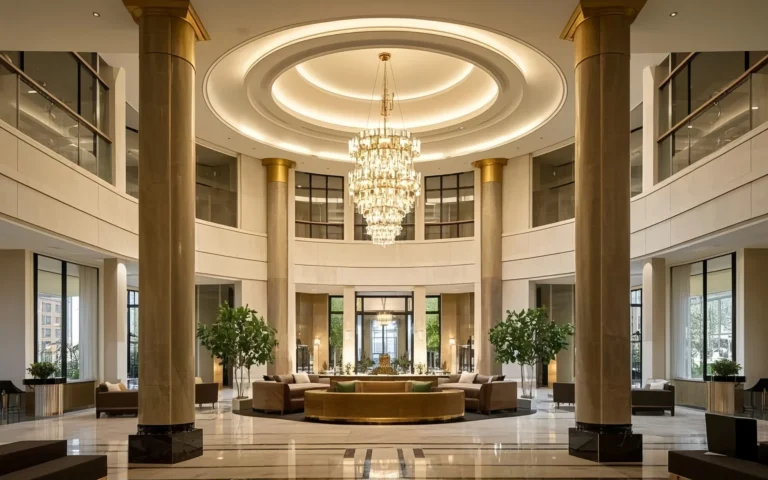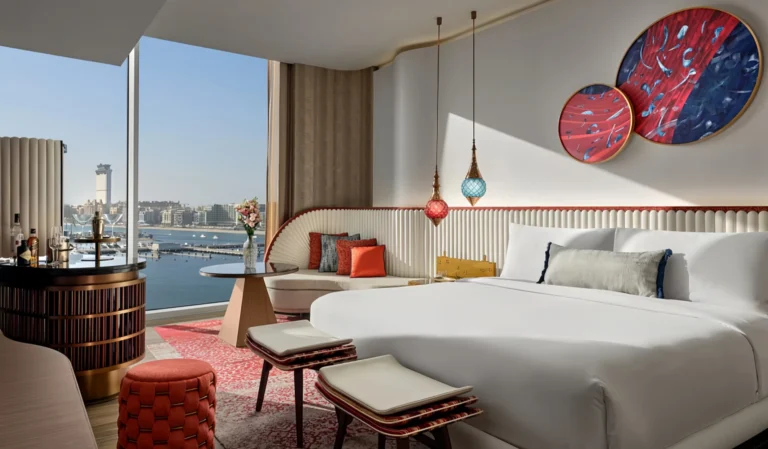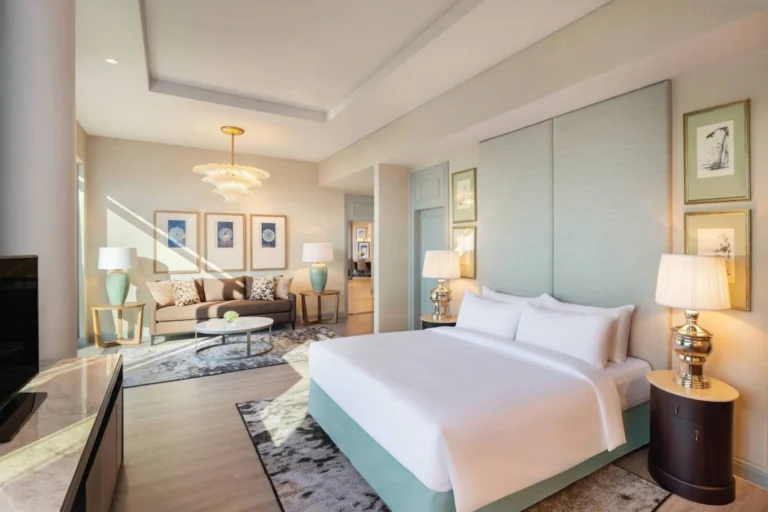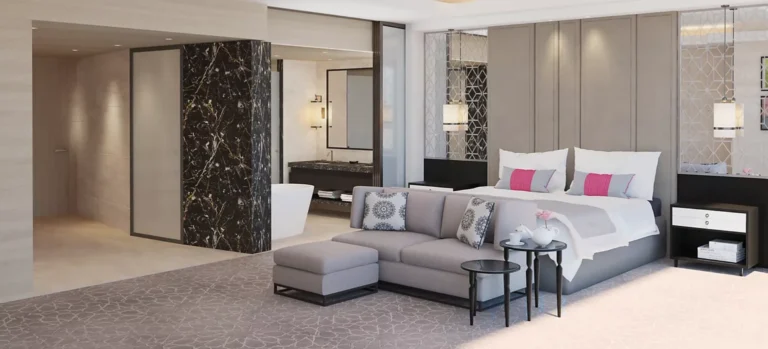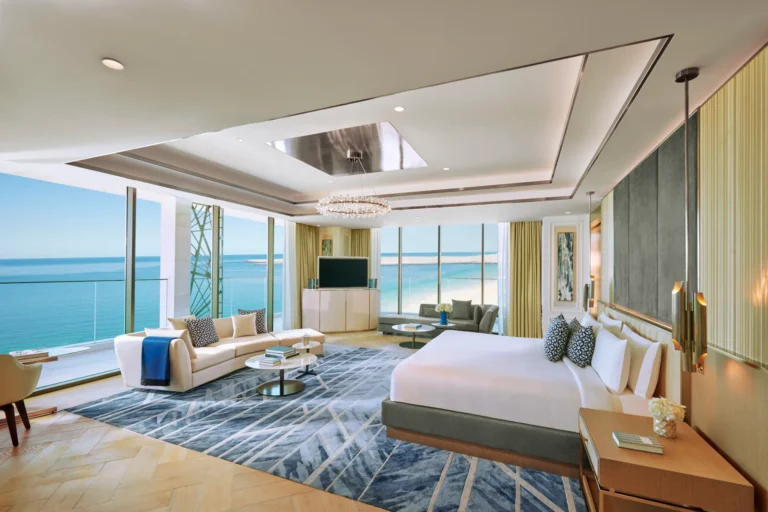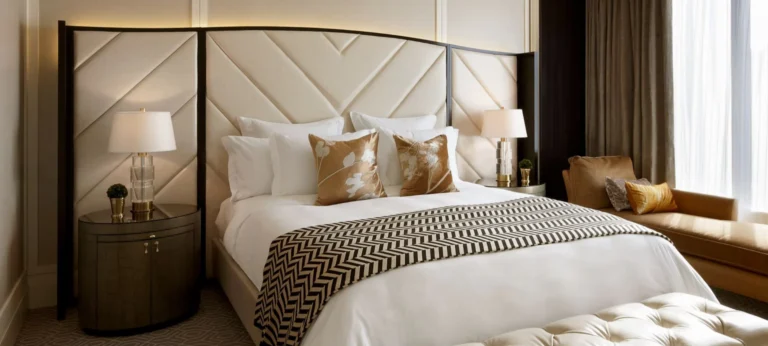Hotel room design is no longer just about furniture and decoration—it has become a strategic tool for enhancing guest experience, strengthening brand identity, and increasing revenue per stay. In 2026, contemporary hotel room design takes center stage as hotels around the world move toward spaces that are minimalist yet warm, functional yet luxurious, and highly personalized.
Modern travelers expect more than a bed and a bathroom. They want spaces that feel comfortable, stylish, and well thought out—spaces that blend residential comfort with hospitality efficiency. As a result, hotels are reimagining guest rooms with custom furniture solutions , smart technology, flexible layouts, and high-end finishes that cater to both leisure and business travelers.
From boutique hotels seeking unique storytelling to 5-star brands redefining modern luxury, the industry is shifting toward design that is experiential, efficient, and emotionally engaging. In this article, we’ll explore the Top 12 Contemporary Hotel Room Design Ideas in 2026, giving you practical inspiration and clear direction on how to transform guest rooms into unforgettable spaces.
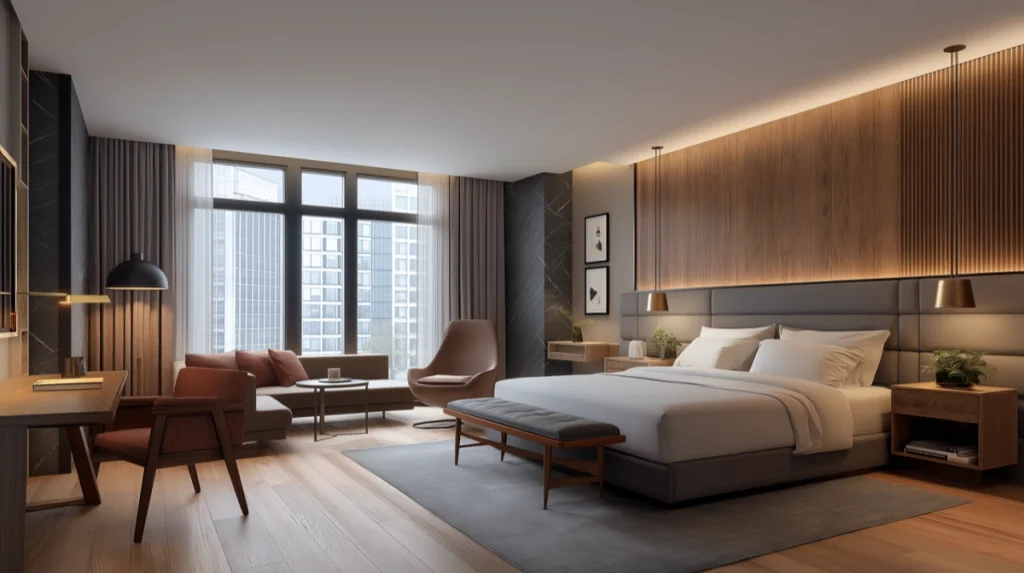
What Defines Contemporary Hotel Room Design in 2026?
Contemporary hotel room design in 2026 goes far beyond appearance—it represents a perfect balance of function, emotion, technology, and brand identity. Unlike traditional or overly decorative interiors, contemporary design focuses on creating comfortable, flexible, and visually clean spaces that adapt to the needs of today’s guests.Here are the core elements that define contemporary hotel room design in 2026:
Clean Lines & Minimalist Aesthetics
Contemporary hotel rooms embrace simplicity with uncluttered layouts, sleek furniture, and neutral color palettes. The goal is to create a calming environment that feels spacious, elegant, and timeless.
Function-Driven Layouts
Every element in a contemporary hotel room has a purpose. Whether it’s smart storage solutions, multi-functional furniture, or seamless transitions between sleeping, working, and relaxing zones, hotel room bedroom design must support both practicality and comfort.
Technology Integration
Modern hotel guests expect smart experiences—automated lighting, keyless entry, adjustable climate, and voice-controlled features. Technology is no longer decorative; it is fully integrated into the room’s design to enhance convenience and efficiency.
Personalized Guest Experience
Contemporary design allows hotels to provide flexible lighting, adjustable layouts, and customizable headboard or furniture options. This level of personalization is especially important in boutique hotel room design and 5-star properties.
Sustainability & Wellness
From eco-friendly materials to improved indoor air quality and biophilic design, contemporary rooms reflect a growing focus on sustainability and well-being. Environmentally conscious guests are more likely to choose hotels that align with their values.
High-Quality Hotel Room Furniture Design
Furniture in a contemporary room is custom-designed to fit the space perfectly. Built-in wardrobes, floating nightstands, integrated desks, and elegant headboards create a cohesive and high-end look. This is why hotel room furniture design and custom hotel furniture are in high demand.
Contemporary hotel room design in 2026 is not just a style—It is a mindset focused on comfort, efficiency, personalization, and modern living.
Top 12 Contemporary Hotel Room Design Ideas
Smart Space Planning for Functional Contemporary Hotel Room Design
This room is a great example of how modern hotels maximize function without sacrificing style. Even with an open layout, the space feels organized, comfortable, and visually balanced—proving that great contemporary hotel room design starts with intelligent planning.
- Clear zoning without walls
The sleeping area, lounge bench, open bathroom, and entryway are visually separated using layout and materials—not bulky partitions. This makes the room feel larger and more luxurious. - Built-in and wall-aligned furniture
The floating headboard, integrated nightstands, and wall-mounted lighting reduce visual clutter and free up floor space. Everything looks clean, custom, and premium. - Vertical and ceiling design adds dimension
The linear ceiling accents draw the eye upward, making the room appear taller and more dynamic. Vertical elements also add architectural interest without using extra furniture. - Open-concept bathroom for a modern touch
Instead of hiding the bathroom behind solid walls, it uses glass partitions and sleek finishes to create a high-end, suite-style experience—popular in 5-star hotel modern interior design. - Thoughtful guest circulation
The pathway from the entry to the bed to the bathroom is wide and unobstructed, allowing guests to move naturally. Every zone feels accessible and intuitive.
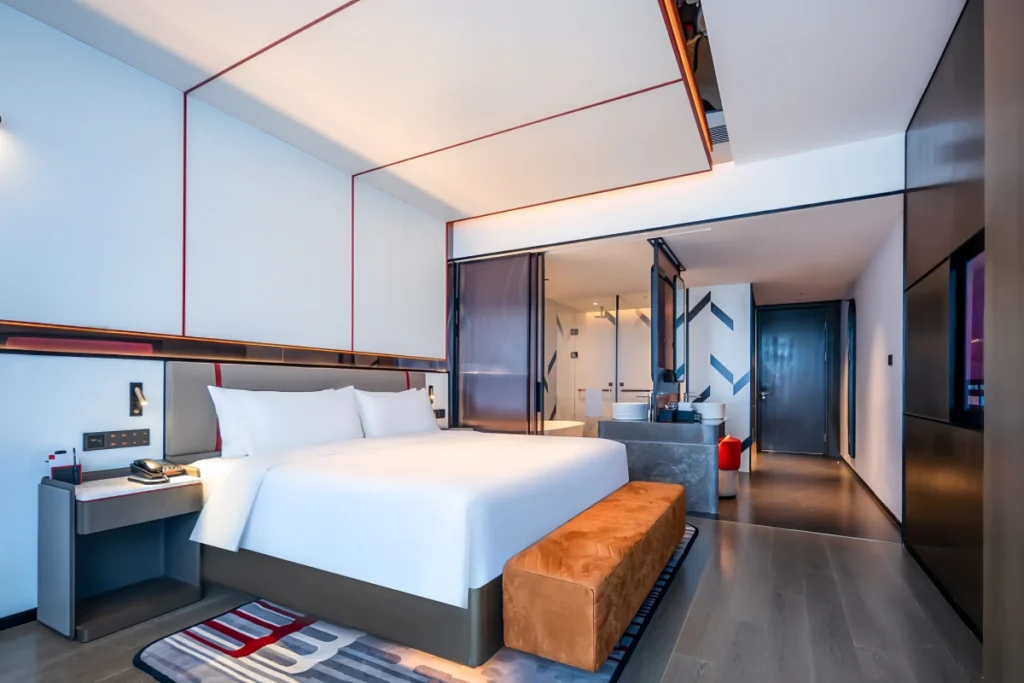
Warm Neutral Palette for a Calm and Luxurious Atmosphere
This room shows how powerful color can be in contemporary hotel room design. Instead of bold patterns or dark tones, it uses a warm neutral palette—soft beige, caramel, terracotta, and light wood—to create a serene and upscale experience.
- Soft, Unified Color Scheme
The walls, furniture, flooring, and fabrics follow the same warm tone family. This consistency creates visual harmony and makes the room look larger and more elegant. - Natural Materials = Natural Comfort
Wood, textured fabrics, and matte finishes add depth without overwhelming the senses. These materials bring a wellness-inspired, boutique hotel feeling. - Light Control for Mood
Floor-to-ceiling windows bring in natural light, while layered curtains allow the room to shift from bright and airy to intimate and relaxing—perfect for both day and night experiences. - Color-Zoned Spaces
Subtle color shifts help define different functional areas (sleeping, lounging, working) without using walls. This keeps the space open but organized. - Emotional Impact
Warm neutrals make guests feel relaxed and safe. Instead of cold minimalism, this design delivers soft luxury—a key direction in 2026 hotel interiors.
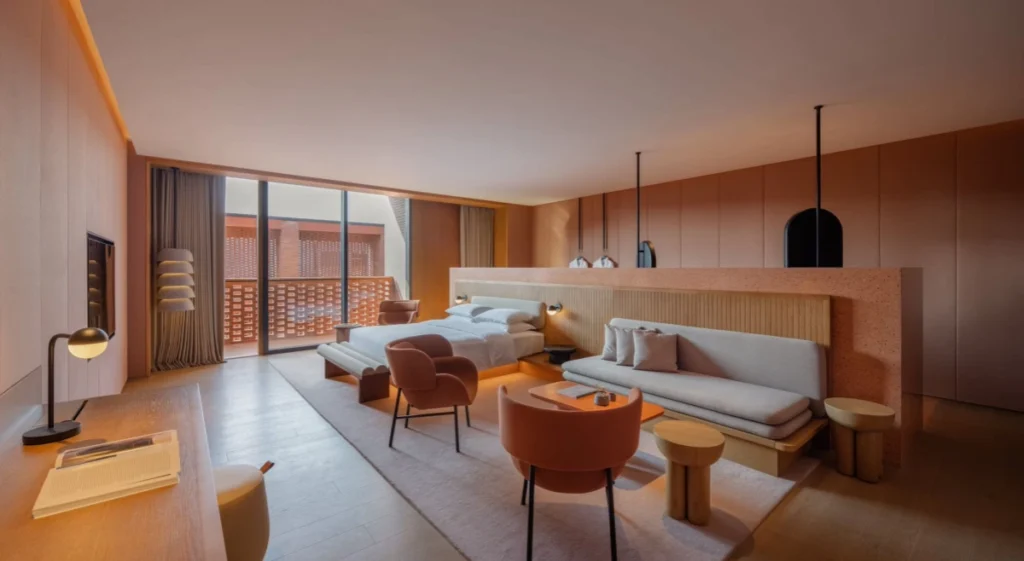
Open-Zone Layout with Soft Division for Flexible Living
This room shows how contemporary hotels are moving away from traditional, closed-off layouts and embracing open, multi-functional spaces. Instead of separating the bedroom and living area with solid walls, the room uses soft zoning to maintain privacy while keeping the space open and airy.
- Visual division without losing openness
A slim vertical partition and ceiling frame subtly define the sleeping area, while still allowing light and sightlines to flow through the space. This makes the room feel larger and more luxurious. - Living room-style comfort inside the guest room
A full sofa, lounge chair, and coffee table create a residential-style living area, making the room ideal for relaxing, reading, or entertaining. This “home-like hotel room” trend is especially popular in boutique and extended-stay hotels. - Smart workspace integration
The desk is positioned near natural light and designed with comfort in mind, making remote work or business tasks more enjoyable—perfect for modern travelers. - Subtle color accents add personality
Neutral furniture is paired with warm accent colors (orange, tan, soft patterns in the floor) for a modern yet approachable aesthetic. It feels stylish without overwhelming the senses. - Functional flow for real guest behavior
Guests can move smoothly from lounging to working to sleeping. Every zone has a purpose, but nothing feels boxed in or restricted.
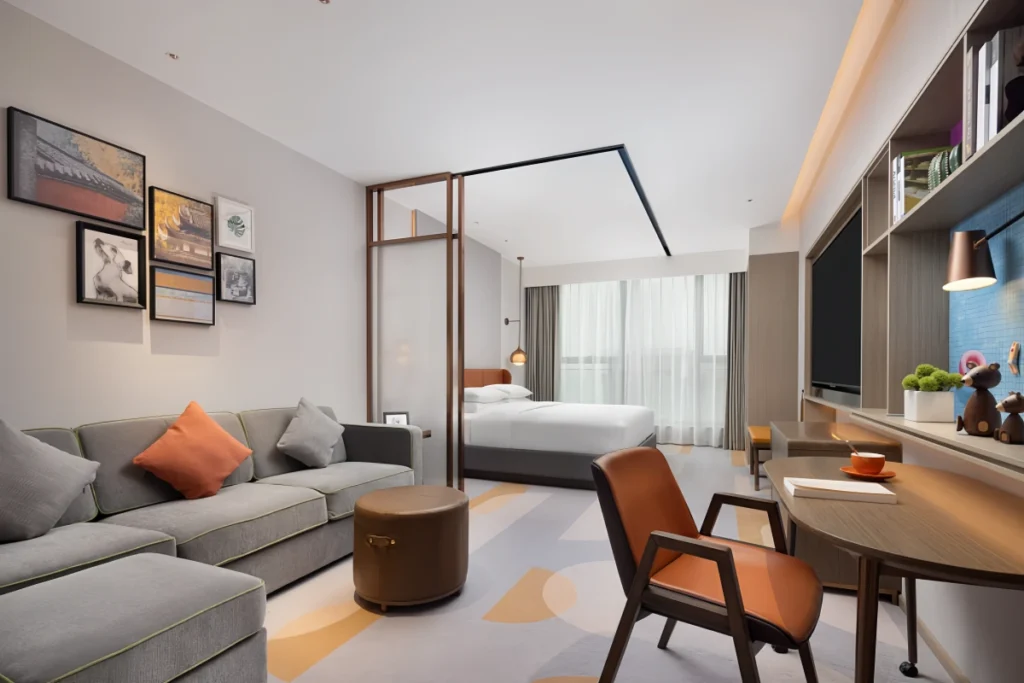
Bold Accent Colors to Energize a Contemporary Hotel Room
Contemporary hotel rooms don’t have to be neutral or dull. This design shows how strategic pops of color can make a space feel lively, modern, and memorable—without overwhelming the guest. Neutral walls and flooring create a calm foundation, while vibrant accents like orange and blue add personality and energy. The result? A room that feels both professional and playful.
- Neutral base, bold accents
The furniture and walls stay in beige and gray, allowing the orange sofa and blue cushions to stand out in a stylish, controlled way. - Color used to define zones
The brighter tones highlight the lounge and seating area, subtly separating it from the sleeping zone without physical dividers. - Modern and youthful brand identity
This palette works especially well for lifestyle hotels, business hotels targeting younger travelers, or urban boutique properties. - Coordinated color story
Accent colors appear in multiple elements—sofa, chair, carpet, art panel—creating visual harmony instead of chaos. - Memorable guest experience
Guests are more likely to remember a room that feels unique and vibrant. A bold-yet-balanced color concept can boost brand recognition and social media sharing.
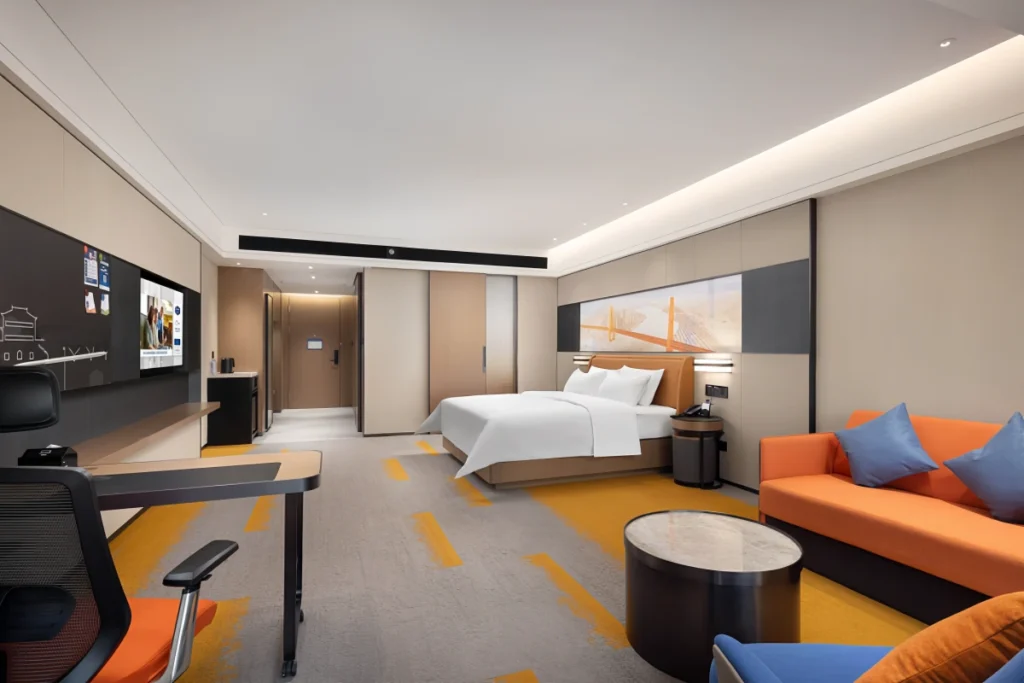
Floor-to-Ceiling Windows for Light-Filled, Modern Hotel Room Design
Natural light is one of the most powerful design tools in contemporary hotel rooms. This space uses floor-to-ceiling windows to create a bright, open, and luxurious atmosphere that instantly enhances the guest experience. Large windows don’t just improve aesthetics—they elevate mood, expand visual space, and connect guests to the outside environment.
- Maximizes natural light
The room feels bigger, fresher, and more welcoming thanks to abundant daylight. This reduces the need for artificial lighting and supports guest wellness. - Clean, uncluttered layout
With the bed, lounge seating, and TV positioned thoughtfully, the layout maintains open sightlines toward the windows—keeping the view as the focal point. - Neutral palette + one accent wall
Soft beige and gray tones create calmness, while the deep blue accent wall adds depth and sophistication without overpowering the space. - Indirect lighting enhances ambiance
Warm LED strip lighting along the ceiling adds a soft glow, bringing evening coziness without breaking the clean modern look. - Luxury through spacious simplicity
Rather than filling the room with furniture, the design lets each piece breathe. This “luxury of space” is a key characteristic of 5-star modern hotel room interior design.
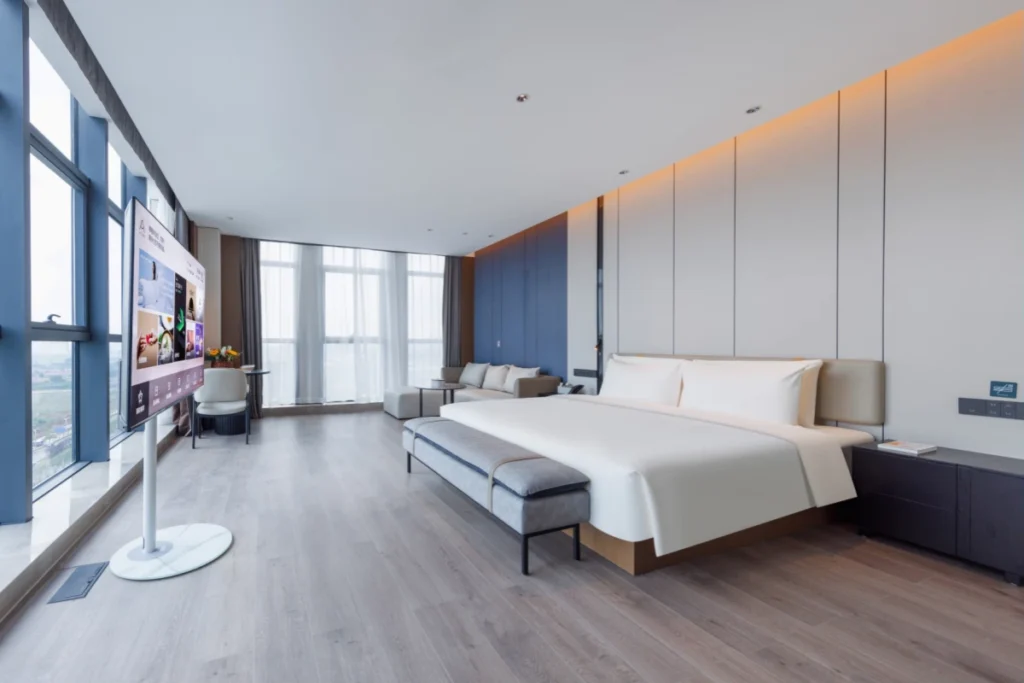
Whether you’re planning a new property or upgrading an existing one, we’re ready to help you create a perfect solution.
Artistic Statement Design to Create a Memorable Guest Experience
Contemporary hotel rooms in 2026 are not afraid to be bold. This design shows how art, color, and unique elements can turn a standard room into an unforgettable experience—perfect for boutique and lifestyle hotels. Instead of playing safe, this room becomes a visual signature that guests will remember, photograph, and share.
- Art as a focal point
The dramatic wall sculpture instantly grabs attention and sets the tone. It transforms the room from ordinary to iconic—this is boutique hotel bedroom design at its best. - Bold contrast color palette
The combination of deep black, electric blue, and crisp white creates high visual impact. The colors feel modern, edgy, and sophisticated. - Geometric patterns for modern energy
The rug and pillows use geometric lines to add movement and rhythm, elevating the contemporary style without overwhelming the space. - Integrated bathtub in the room
Bringing a freestanding tub into the bedroom area adds a sense of luxury and lifestyle. It’s a signature element often seen in 5-star hotel modern room interior design. - Lighting enhances drama
Pendant lamps and indirect lighting highlight textures and shapes, creating depth and atmosphere—essential in statement design.
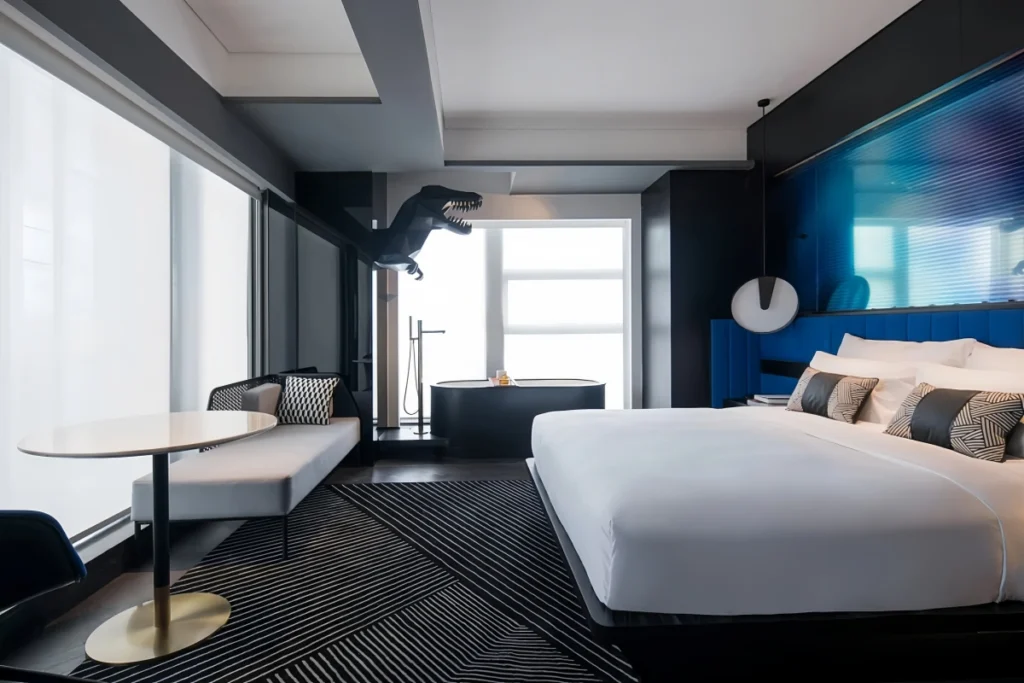
Seamless Smart Technology Integration for a High-Tech Guest Experience
In contemporary hotel room design, technology isn’t just an add-on—it’s built into the room from the start. This design shows how to integrate smart features in a clean, elegant, and user-friendly way that enhances comfort without overwhelming the aesthetic.
- Wall-mounted smart TV with soundbar
The TV and sound system are seamlessly integrated into the wall, keeping the design clean while offering premium entertainment. No messy cables, no bulky furniture—just sleek functionality. - Smart lighting with ambiance control
Notice the indirect lighting in the bedroom and the neon accent lighting in the adjacent area. Guests can switch from relaxing mood lighting to vibrant energy with just a touch—perfect for both leisure and business travelers. - Connected spaces through open tech zones
The sliding door reveals a tech-enabled lounge area with illuminated shelving and artwork. This gives the room a futuristic feel and adds personality to the environment. - Floor-to-ceiling windows enhance digital + natural balance
Technology is balanced with nature—large windows bring in natural light and city views, preventing the space from feeling cold or artificial. - Convenience-focused design
Outlets and switches are placed right where guests need them—next to the bed, desk, and lounge areas. Great tech design is not just about devices, but ease of use.
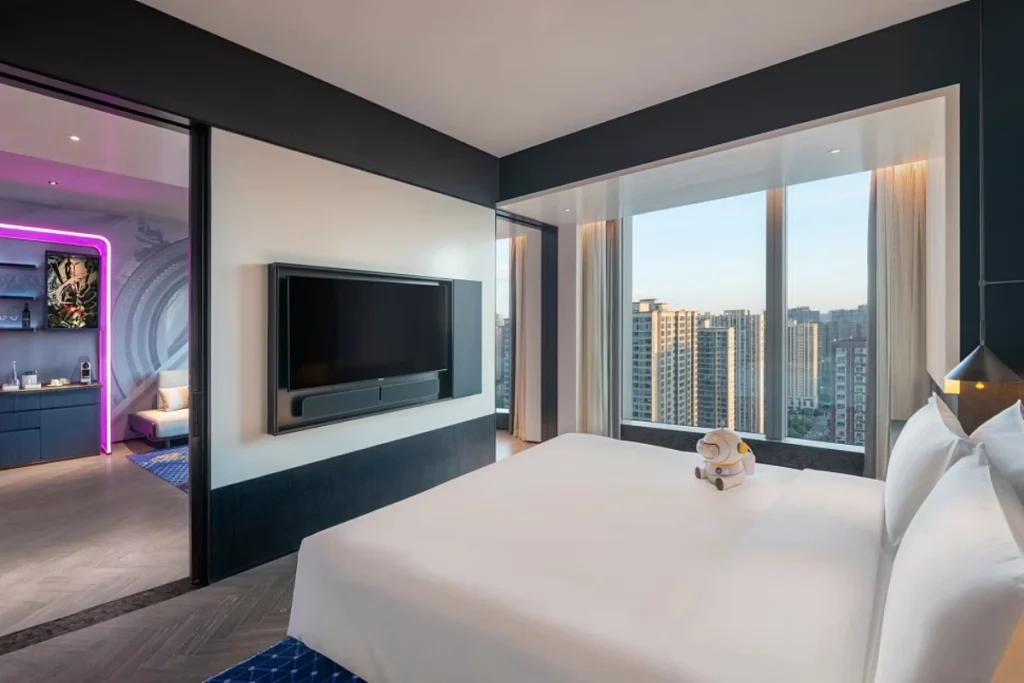
Statement Headboard and Ceiling Design for a Luxury Focal Point
In high-end contemporary hotel rooms, the bed wall is the hero of the space. This design uses an architectural headboard and ceiling feature to create a dramatic, luxurious focal point that instantly elevates the entire room. Instead of using artwork or patterns, the room lets form, texture, and lighting do the talking.
- Vertical panel headboard adds height and texture
The tall, ribbed wall behind the bed makes the room feel larger and more elegant. The rich brown tone adds warmth and depth without needing extra decoration. - Ceiling extension frames the bed
By extending the same material from the wall onto the ceiling, the design creates a “sleeping zone” that feels cozy and high-end—like a private cocoon within the room. - Indirect lighting highlights architectural details
Hidden LED lighting along the ceiling and floor adds a soft glow, emphasizing texture and creating a 5-star hotel mood without using lamps everywhere. - Sculptural bedside lighting
The circular hanging lights act as functional art. They replace traditional table lamps and add a futuristic, boutique feel. - View integration for ultimate experience
The bed faces a full panoramic window, allowing guests to wake up to natural light and skyline views—a luxury that modern travelers love.
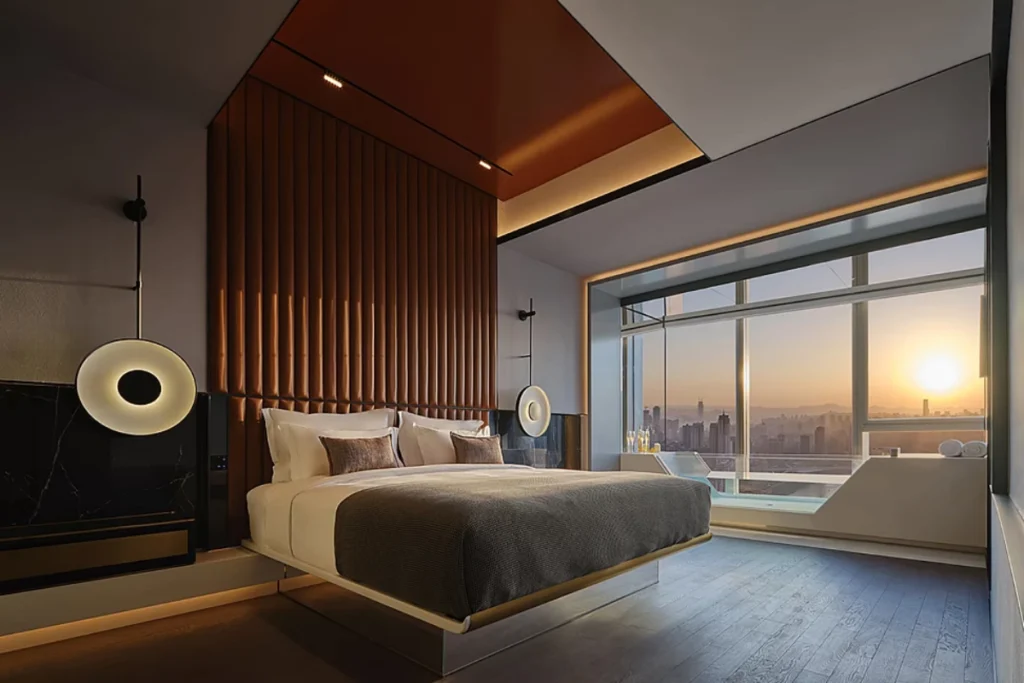
Architectural Bed Canopy for a Cozy and Futuristic Sleeping Zone
This design shows how a built-in bed canopy structure can completely transform a hotel room. Instead of a standard flat wall, the bed area is framed with sculptural curves that extend from the wall to the ceiling, creating a private, cocoon-like sleeping zone within an open space. This approach blends architecture, interior design, and lighting—a true contemporary statement.
- Curved wall-to-ceiling design adds softness and depth
The smooth, rounded lines feel modern and futuristic, while eliminating the hard edges of traditional rooms. It’s visually striking and emotionally comforting. - Floating bed with underlighting
The bed appears to float above the floor with soft LED lighting underneath. This adds a luxury hotel effect while making the space feel light and airy. - Integrated indirect lighting
LED strips along the canopy and headboard create warm, ambient light without visible fixtures. This enhances mood and keeps the design clean. - Artistic accent wall in the lounge area
The oversized moon artwork adds drama and character, balancing the futuristic sleeping area with a stylish, boutique hotel vibe. - Seamless transition between zones
The sofa, table, and bed each have their own space but feel naturally connected. The layout supports both relaxation and functionality.
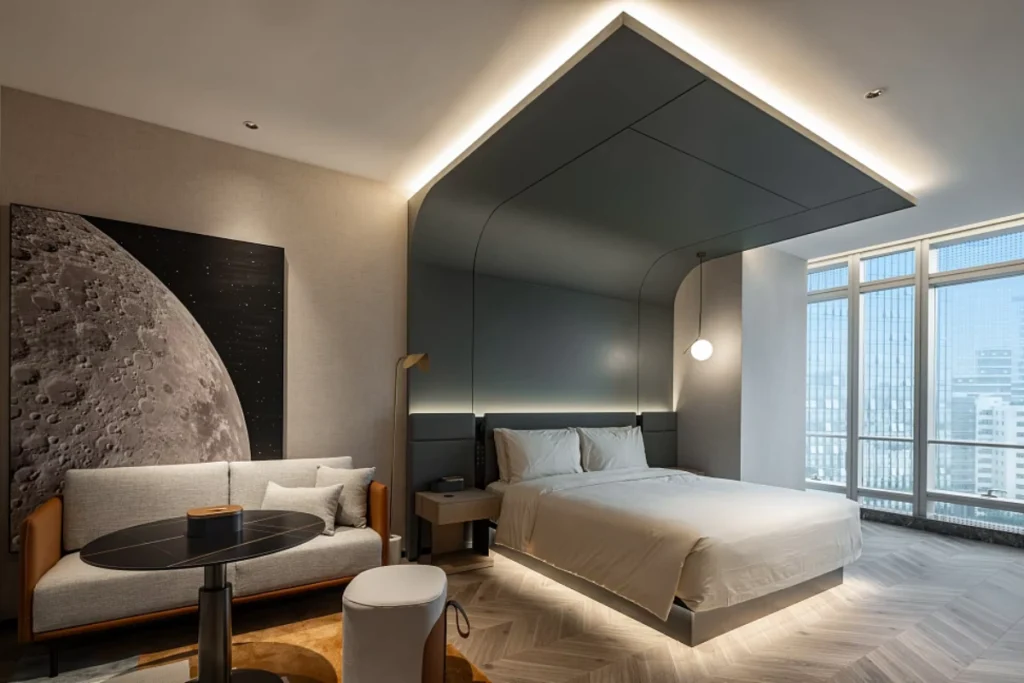
Soft Luxury Through Textures and Layered Lighting
Not all luxury needs to be bold—sometimes the most high-end hotel rooms feel calm, soft, and effortlessly elegant. This design uses layered textures, subtle colors, and ambient lighting to create a warm and sophisticated atmosphere that feels truly 5-star.
- Neutral tones with depth
The palette is soft and muted—taupe, beige, grey—but the space doesn’t feel flat because different materials (fabric, wood, leather, carpet) add rich visual texture. - Large-scale artistic headboard
The oversized abstract art behind the bed becomes a quiet focal point. It adds personality and movement while keeping the overall look elegant and modern. - Layered lighting for mood and function
The room uses a combination of:
● Indirect cove lighting for ambiance
● Pendant lights for style
● Task lamps for function
This layered lighting creates a cozy and luxurious hotel bedroom design without any harsh brightness. - Lounge seating for lifestyle comfort
A daybed and accent chair create a relaxing corner perfect for reading, working, or enjoying room service—enhancing the residential luxury feel. - Minimalist furniture, maximum comfort
The furniture has clean lines and slim profiles, avoiding clutter while still feeling plush and inviting.
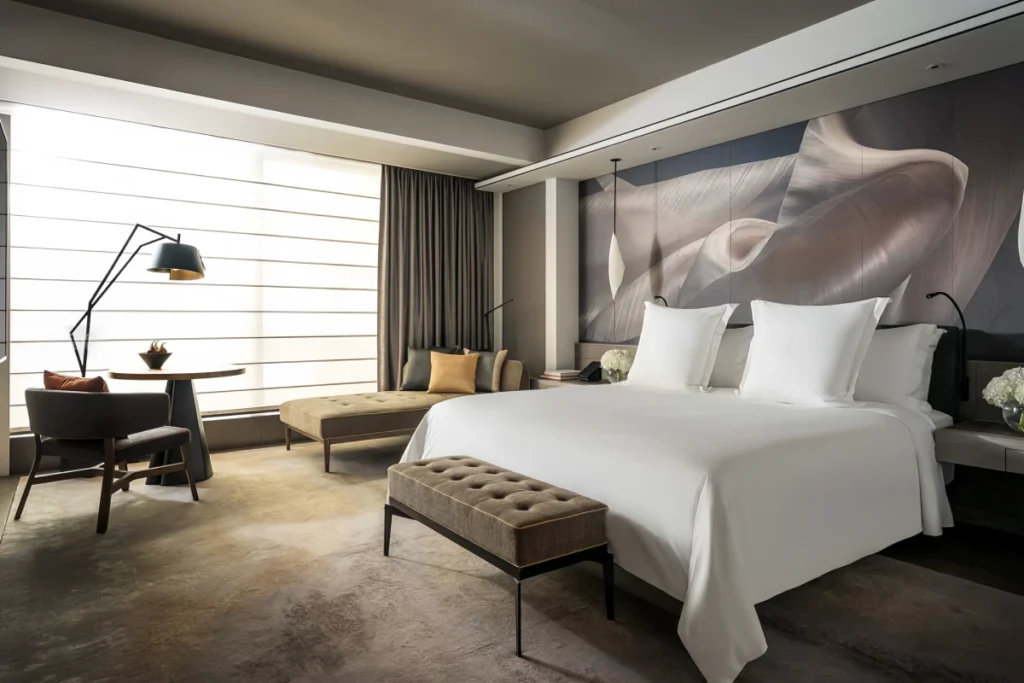
Whether you’re planning a new property or upgrading an existing one, we’re ready to help you create a perfect solution.
Soft Curves and Organic Shapes for a Relaxed Luxury Feel
Contemporary hotel room design in 2026 is moving away from harsh lines and sharp edges. Instead, designers are embracing soft curves and organic shapes to create a calm, welcoming, and high-end experience. This room is a great example of how rounded forms can make a space feel more human, more comfortable, and effortlessly elegant.
- Curved ceiling and lighting feature
The circular recessed ceiling with soft lighting instantly draws attention and creates a soothing, spa-like ambiance. - Rounded furniture for flow and comfort
From the curved sofa to the oval tables and bench, every piece of furniture uses smooth edges that make the space feel inviting and safe. - Gentle wall panels for visual softness
Vertical wall panels add texture without being harsh. Their rounded edges enhance the softness while keeping the modern look. - Organic patterns in the rug
The abstract rug introduces natural shapes and muted colors, balancing sophistication with warmth. - Boutique-level details
Stylish lighting, layered pillows, mixed materials, and artistic accents give this room a luxury boutique hotel personality rather than a standard chain hotel look.
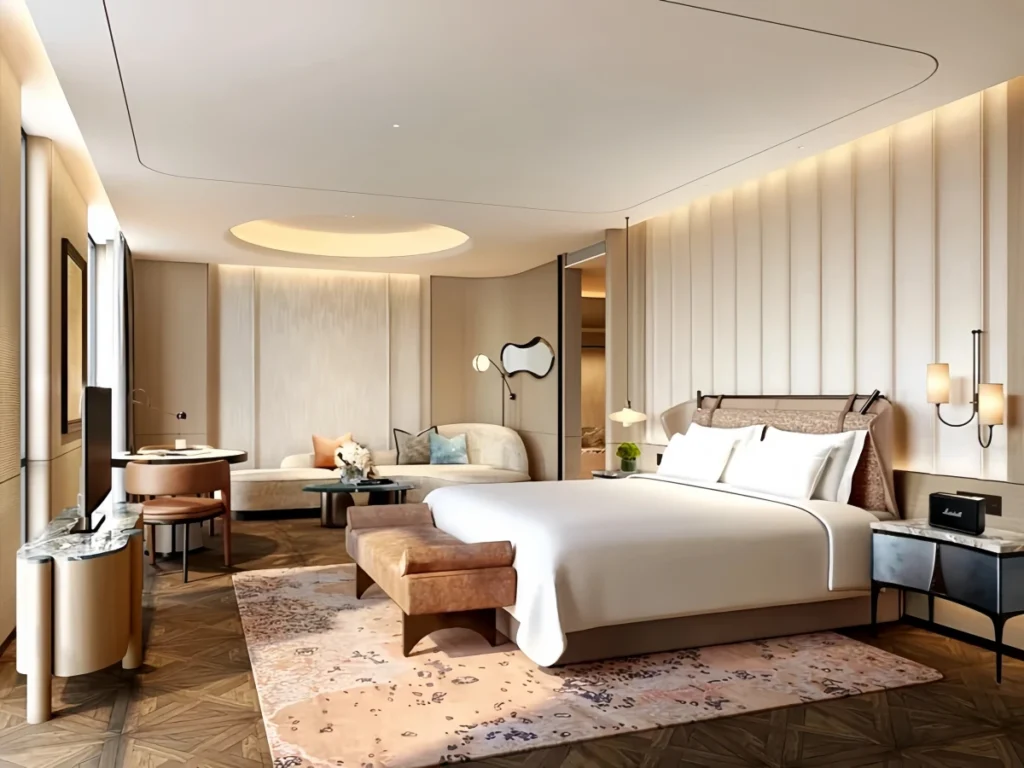
Built-In Details and Custom Furniture for a Tailored, High-End Look
One of the biggest trends in contemporary hotel room design for 2026 is the use of custom-built elements and integrated furniture to create a seamless, polished, and highly functional space. This room is a perfect example of how tailored design elevates both aesthetics and guest experience.
- Custom headboard wall with texture and lighting
The full-width, floor-to-ceiling headboard creates a unified visual backdrop. Vertical padded panels add softness and dimension, while the hidden LED lighting at the top adds warmth and ambience. - Built-in nightstands and outlets
Nightstands are seamlessly attached to the headboard wall, saving space and maintaining a clean line. Integrated power outlets and controls are placed right where guests need them—smart and convenient. - Window bench for added comfort and functionality
The custom bay window seat provides a cozy lounging spot with natural light and city views—perfect for reading, relaxing, or even working. - Coordinated furniture design
The bench at the end of the bed, the curved edge console, and the layered table all share consistent shapes and materials. This creates a cohesive, designer feel throughout the room. - Tailored finishes = Luxury without excess
Instead of using lots of decor, the room relies on precision detailing, quality materials, and integrated lighting to express luxury in a modern way.
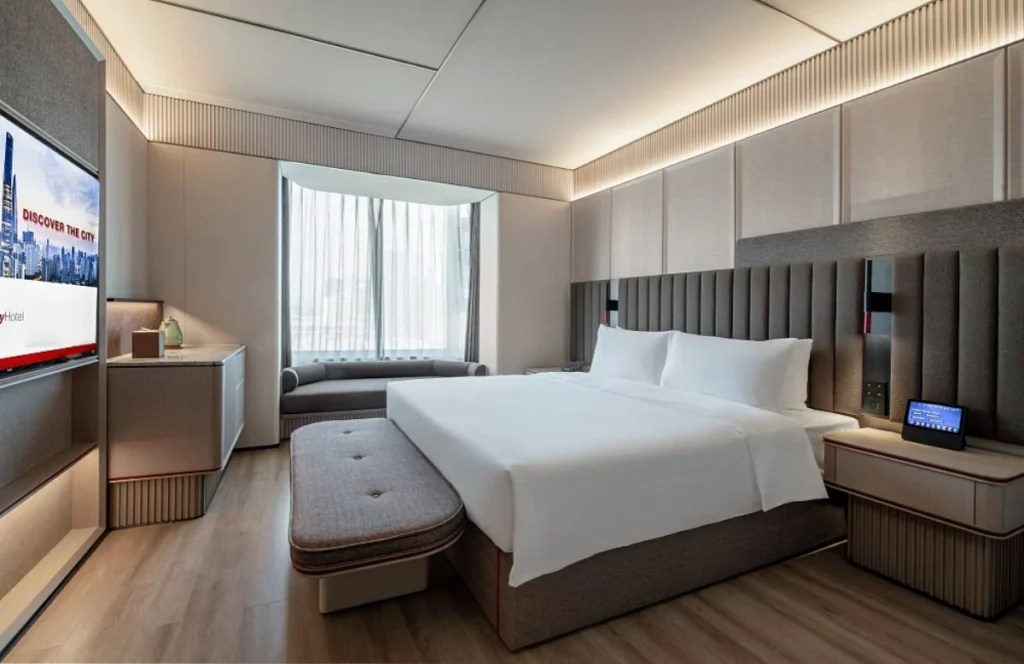
How to Choose the Right Design Style for Your Hotel Project
Choosing between contemporary, boutique, and luxury hotel room design isn’t just about aesthetics—it’s a business decision. The right design style should reflect your target guests, brand positioning, budget, and market expectations. Here’s a clear framework to help you make the right choice:
1. Identify Your Target Guests
Different travelers expect different types of design:
| Guest Type | Best Design Style |
|---|---|
| Business Travelers | Contemporary |
| Young / Lifestyle Travelers | Boutique or Contemporary-Boutique mix |
| High-End Luxury Travelers | Luxury |
| Long-Stay Guests | Contemporary + Residential comfort |
| Couples / Leisure Guests | Boutique or Luxury |
2. Analyze Room Size & Space Layout
Space influences style more than you think.
- Small rooms: Contemporary (smart furniture, minimal clutter), Boutique (creative layouts, multifunctional design)
- Medium rooms: Contemporary with personality, Boutique with custom elements
- Large rooms / suites: Luxury (spacious, layered zones, premium finishes), Boutique-Luxury hybrid
3. Set a Realistic Budget
Design style affects both furniture cost and construction complexity:
- Contemporary: Most cost-efficient (simple shapes, modular pieces)
- Boutique: Medium to high (custom details, unique materials)
- Luxury: Highest (premium materials, large spaces, custom everything)
4. Clarify Your Brand Identity
Your room design should tell your brand story:
- Comfort and simplicity → Contemporary
- Art, culture, uniqueness → Boutique
- Prestige and exclusivity → Luxury
- Modern yet stylish → Contemporary + Boutique
- Minimal yet premium → Contemporary + Luxury
5. Consider Your Market (Local vs Global Expectations)
- Urban business cities: Contemporary / Contemporary-Luxury
- Tourist destinations / cultural cities: Boutique / Boutique-Luxury
- High-end international resorts: Luxury / Bespoke contemporary
- Emerging markets: Contemporary (functional, scalable, cost-effective)
Conclusion: The Future of Hotel Room Design Is Contemporary, Experiential, and Customized
Hotel room design in 2026 is no longer just about looking stylish—it’s about how a space makes guests feel and how well it performs in real-world use. The most successful hotels are those that combine:
- Contemporary aesthetics – clean, modern, comfortable
- Boutique personality – unique, memorable, emotionally engaging
- Luxury elements – premium materials, layered lighting, spacious layouts
But the true differentiator is not just design—it’s execution.
Your room can only reach its full potential when the furniture, layout, lighting, and materials all work together as one seamless experience. And that’s why more and more hotels are embracing custom furniture to match their brand, optimize their space, and deliver a higher level of guest satisfaction.
The hotels that stand out in 2026 will be those that:
- Understand their target guests
- Choose the right design style (Contemporary, Boutique, Luxury—or a blend)
- Invest in smarter layouts and better furniture
- Use customization to express their brand and maximize space
- Partner with manufacturers who can deliver quality and consistency
Censo Home – Your Partner in Contemporary Hotel Room Design & Furniture
At CenSo Home , we don’t just make furniture—we help you build signature hotel spaces that guests love and remember. We combine:
- Design strategy
- Custom furniture manufacturing
- Full-room solutions (bedroom, lobby, restaurant, public areas)
- Global export & installation support
- Quality + Style + Function + Durability
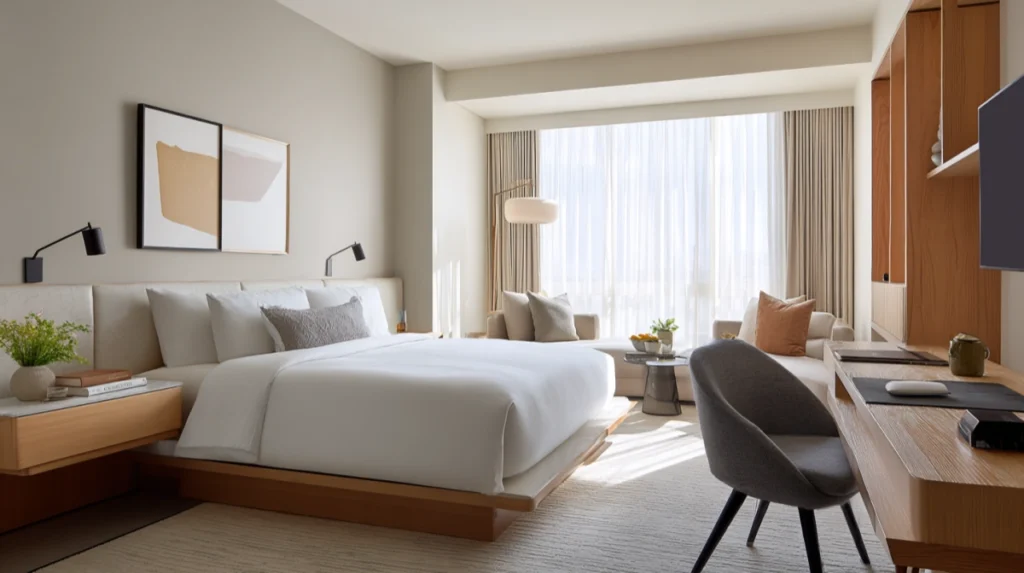
Whether you’re planning a new property or upgrading an existing one, we’re ready to help you create a perfect solution.

